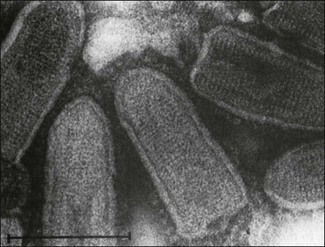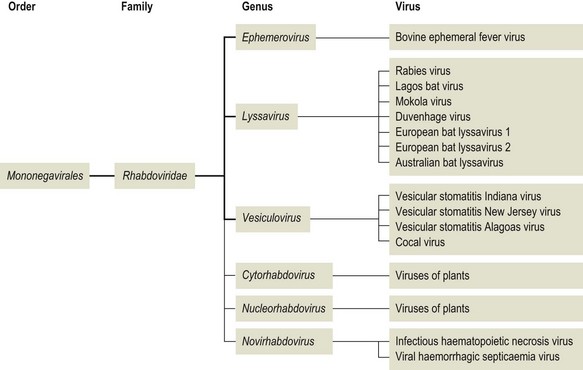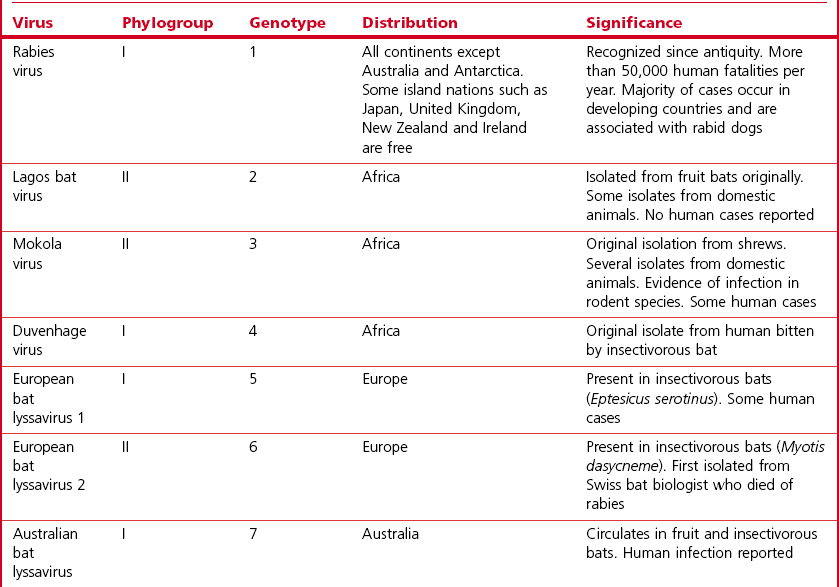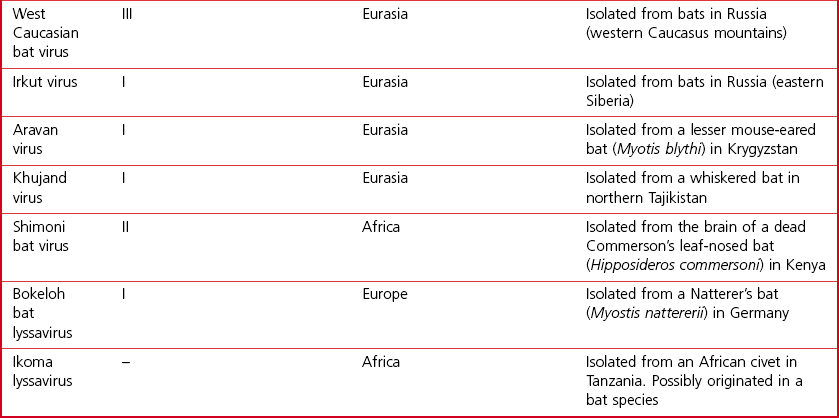Chapter 63 Rhabdoviruses are named from the Greek word rhabdos meaning rod which refers to their distinctive morphology. The family Rhabdoviridae along with the families Paramyxoviridae, Bornaviridae and Filoviridae is part of the order Mononegavirales. Viruses within this order possess a linear non-segmented RNA genome of negative polarity in a helical ribonucleoprotein complex (RNP). Rhabdoviruses are enveloped and variable in length, 100–430 nm, and diameter, 45–100 nm. The animal viruses are bullet-shaped while plant rhabdoviruses may be bacilliform- or bullet-shaped (Fig. 63.1). It is a large family comprising six genera Vesiculovirus, Lyssavirus, Ephemerovirus, Novirhabdovirus, Cytorhabdovirus and Nucleorhabdovirus (Fig. 63.2). In addition there are a large number of rhabdoviruses which have not been assigned to any genus yet. Members of the family infect vertebrates, invertebrates and plants. The genera Vesiculovirus, Lyssavirus and Ephemerovirus contain viruses of vertebrates. The genus Novirhabdovirus contains infectious haematopoietic necrosis virus and related rhabdoviruses of fish. Figure 63.1 Negative stain electron microscopy of vesicular stomatitis Indiana virus showing characteristic bullet-shaped virions. Bar: 100 nm. Reprinted with permission: Veterinary Virology Third Edition (1999). Murphy et al., Academic Press. Page 431. The family contains more than 150 viruses of vertebrates, invertebrates and plants, of which a number are of veterinary significance (Table 63.1). Transmission of rhabdoviruses frequently involves an arthropod vector. Arthropods are thought to be the original reservoir hosts from which adaptation to plants and vertebrates occurred. Transmission between vertebrate hosts can also occur by contact, aerosol, bite or venereally. The best known and most important member of the family is rabies virus which is a member of the genus Lyssavirus. The name of the genus is derived from the Greek word lyssa meaning rage or fury. More than 25 viruses isolated from vertebrates and invertebrates have been described in the genus Vesiculovirus. Several vesiculoviruses are known to infect domestic animals, of most importance are vesicular stomatitis Indiana virus (VSIV) and vesicular stomatitis New Jersey virus (VSNJV). Infection of man with these viruses is reasonably common and results in an influenza-like condition. Bovine ephemeral fever or three-day sickness is caused by bovine ephemeral fever virus, the type species of the genus Ephemerovirus. Rhabdoviruses are important causes of disease in fish including infectious haematopoietic necrosis virus, viral haemorrhagic septicaemia virus, eel rhabdovirus, pike fry rhabdovirus and spring viraemia of carp virus. A number of these viruses are members of the genus Vesiculovirus while others have been assigned to the genus Novirhabdovirus. Table 63.1 Members of Rhabdoviridae of veterinary significance Rabies is a viral infection of the CNS of warm-blooded animals, including man, that usually ends in death of the host. The disease occurs in most parts of the world. All mammals are considered susceptible to infection. The vast majority of clinical cases are due to infection with rabies virus. Several genotypically distinct lyssaviruses are capable of producing rabies-like encephalitis but incidences of human disease due to these ‘rabies-related’ viruses are rare. Antigenic and genetic sequencing studies have allowed the differentiation of at least four serotypes and seven genotypes (Smith 1996, Gould et al. 1998, Marston et al. 2012). The genotypes are sufficiently different to be ascribed separate species status (Table 63.2). An additional five lysssaviruses have been isolated from a number of bat species and classified; West Caucasian bat virus, Shimoni bat virus, Aravan virus, Irkut virus and Khujand virus. Two further lyssaviruses, one from a bat (Bokeloh bat virus) and one from an African civet (Ikoma lyssavirus) have been detected (Marston et al. 2012). All warm-blooded animals are susceptible to infection with rabies virus. However, there is species variation in susceptibility and several species-adapted variants of rabies virus occur. Each variant is more readily transmitted to members of the same species than to individual animals of a different species. In a particular geographical area rabies virus is usually maintained and transmitted by one or possibly two mammalian species. These species serve as reservoirs and vectors of the infection. Two important epidemiological cycles are recognized, canine (urban) rabies and sylvatic rabies. Canine rabies involves stray dogs and accounts for more than 95% of human cases in developing countries. Sylvatic rabies involves a range of wildlife species, principally small to medium-sized carnivores, that varies geographically and includes foxes, coyotes, racoons, skunks, jackals, mongooses and bats. Rabies virus exploits a number of traits common to these reservoir hosts including the fact that they often live at high population densities and have high intrinsic population growth rates which permit the rapid recovery of a population following a rabies epizootic. In Africa, Asia, South America and the Middle East canine rabies is important whereas in developed countries vaccination and the control of strays have reduced its importance but increased awareness of wildlife reservoirs. In North America racoons, skunks, foxes and bats act as important reservoirs (Krebs et al. 1998). In Europe, the principal reservoir is the red fox. The vampire bat is an important reservoir in Central and South America. In Africa, the predominant rabies virus variants are the mongoose and canine biotypes.
Rhabdoviridae

Virus
Host species
Significance of infection
Rabies virus
Wide host range
Present in a wide range of mammalian species. Canine (urban) and sylvatic cycles. Fatal central nervous disease. Worldwide except for Australia and island countries
Vesicular stomatitis Indiana virus
Cattle, sheep, horse, pig, man
Febrile vesicular disease similar to foot-and-mouth disease. Type virus of the genus
Vesicular stomatitis New Jersey virus
Cattle, sheep, horse, pig, man
Febrile vesicular disease similar to foot-and-mouth disease
Vesicular stomatitis Alagoas virus (Brazil virus)
Horse, mule, cattle, man
Originally isolated from mules in Alagoas, Brazil. Pathogenic for cattle and horses
Cocal virus (Argentina virus)
Arthropods, horses
First isolated from mites in Trinidad. Associated with disease in horses
Bovine ephemeral fever virus
Cattle
Febrile, arthropod-borne illness present in tropical and semi-tropical regions of Africa, Asia and Australia
Rabies
< div class='tao-gold-member'>
![]()
Stay updated, free articles. Join our Telegram channel

Full access? Get Clinical Tree





